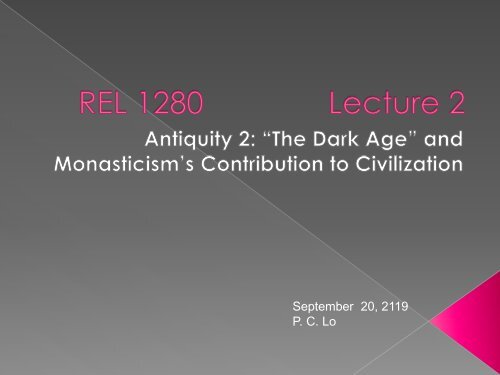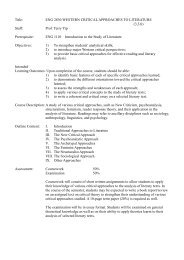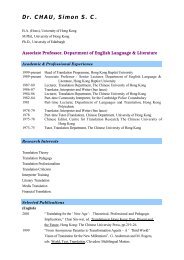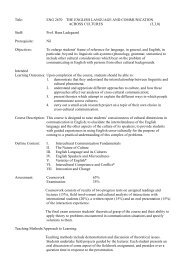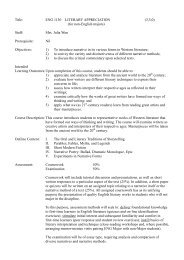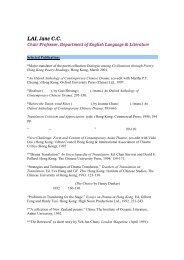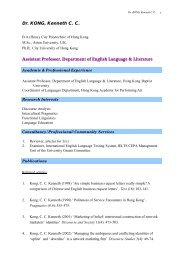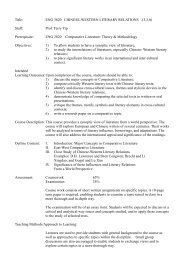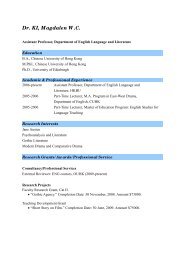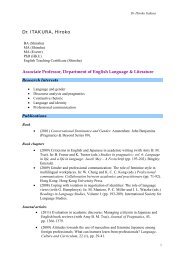Reading (2)
Reading (2)
Reading (2)
Create successful ePaper yourself
Turn your PDF publications into a flip-book with our unique Google optimized e-Paper software.
September 20, 2119<br />
P. C. Lo
A. The Fall of the Roman Empire<br />
B. The ‚Dark Age‛<br />
C. How the Monks Saved Western<br />
European Civilization<br />
Irish contribution<br />
Benedict‟s contribution<br />
Non-Christian monasticism and other<br />
Civilizations<br />
copyright P C lo 2
姚介厚, 李鹏程, 杨深著,《西歐文明》,頁<br />
155-59。<br />
經濟<br />
政治<br />
文化<br />
蠻族入侵<br />
copyright P C lo 3
‚羅馬民族高昂、進取的道德精神已喪失殆<br />
盡,社會道德風氣極為敗壞‛<br />
‚羅馬全年娛樂假日公元1世紀時為66天,4<br />
世紀時竟達175天,近半年時日沉湎于觀看奴<br />
隸角鬥、鬥獸、海戰、戲劇等表演‛(頁157)<br />
copyright P C lo 4
copyright P C lo 5
匈奴人(Huns),日耳曼諸部落<br />
(Germanic tribes)武裝非法移民<br />
《西歐文明》,頁158。漢帝國與羅馬帝國<br />
3次大入侵及洗劫<br />
‚vandalism”<br />
Hungary<br />
Germanic tribes – Angles, Saxons, Jutes,<br />
Franks<br />
Angles Angland England<br />
copyright P C lo 6
copyright P C lo 7
copyright P C lo 8
copyright P C lo 9<br />
AD 476<br />
(南北朝)
《關於羅馬人的二十個問題》,頁163。<br />
copyright P C lo 10
“the growth of so mighty an empire as<br />
Rome‟s was by no means inevitable.<br />
Rome‟s greatness had come from<br />
conquests that provided the Romans<br />
with the means to expand still further,<br />
until there were not enough Romans to<br />
conquer and govern any more peoples<br />
and territory.<br />
copyright P C lo 11
“When pressure from outsiders grew, the<br />
Romans lacked the resources to<br />
advance and defeat the enemy as in<br />
the past…Without new conquests to<br />
provide the immense wealth needed to<br />
defend and maintain internal prosperity,<br />
the Romans finally yielded to<br />
unprecedented onslaughts by fierce<br />
and numerous attackers.”<br />
copyright P C lo 12
“Like similar empires<br />
in the ancient world,<br />
it had been unable<br />
to sustain its<br />
„Immoderate<br />
greatness‟” (Kagan,<br />
Ozment, Turner, The<br />
Western Heritage, 10 th<br />
ed. 2010, p.162)<br />
copyright P C lo 13
認識真正的中世紀<br />
<strong>Reading</strong> (1):姚介厚、李鹏程、 杨深著,<br />
《西歐文明》,頁163-166。(‚如何認識西<br />
歐中世紀文明‛)<br />
早期中世紀(Early Middle Ages)<br />
鼎盛期中世紀(High Middle Ages)<br />
後期中世紀(Late Middle Ages)<br />
copyright P C lo 14
‚從西羅馬帝國滅亡到約公元1000年的500餘<br />
年間,西歐由於日耳曼蠻族入侵和公元9世紀<br />
斯坎的納維亞半島蠻族南侵,確實兩番出現<br />
了戰亂頻仍、經濟衰敗、政局混亂、古希臘<br />
羅馬文化傳統慘遭破壞殆盡的滿目瘡痍景象<br />
,看來是一種文明的大倒退,所謂中世紀是<br />
‘黑暗時代’,主要是就此而言。‛(姚介<br />
厚、李鹏程、 杨深著,《西歐文明》,頁<br />
164)<br />
copyright P C lo 15
Buildings in Rome crumbled<br />
Looting<br />
Highway robbers<br />
Highway police and customs guards extort<br />
bribes<br />
Kidnapping and trafficking of children<br />
Enslavement of freemen and women<br />
Burned libraries<br />
copyright P C lo 16
Homer and Virgil and all of classical poetry<br />
Herodotus and Tacitus and all of classical<br />
history<br />
Demosthenes and Cicero and all of<br />
classical oratory<br />
Plato and Aristotle and all of Greek<br />
philosophy<br />
Plotinus and Porphyry and all the<br />
subsequent commentary<br />
Tragedies of Aeschylus, Sophocles, and<br />
Euripides (really lost)<br />
copyright P C lo 17
‚西羅馬帝國滅於蠻族之手,主要是因為它自身已經<br />
完全腐敗了,已無抵御強敵之力;羅馬文明向中世<br />
紀文明的轉變也得靠蠻族的外部力量,因為衰落的<br />
羅馬文明已完全失去自我革新的機制與活力。西歐<br />
的這種階段性文明的轉變是極為痛苦、曲折的。羅<br />
馬文明的輝煌成就慘遭毀滅性破壞,希臘羅馬的精<br />
神瀕于滅絕,只在基督教內部以神學形式有所傳承,<br />
又靠阿拉伯民族保存其文化遺產,直到中世紀盛期<br />
和至文藝復興時期才得以重放光彩。西歐文明受嚴<br />
重挫折,它走上封建化道路經歷了漫長的所謂‘黑<br />
暗時期’,文明的轉型艱難地經歷了幾個世紀。<br />
copyright P C lo 18
與此相比較,古代中國從奴隸制向封建制的社<br />
會轉型,雖然從戰國至秦漢也經歷了內戰,<br />
但主要是通過中華文明(文化上主要是儒家、<br />
法家、道家等)自身內部的變革機制實現的,<br />
并非在外部蠻族力量毀滅性的打擊后才完成<br />
自身的階段性文明轉型,古代中華文明的這<br />
種轉型相對平和而有連續性。中世紀千餘年<br />
中華文明比西歐中世紀文明更為優越、繁盛,<br />
其主要原因之一,是它有自身變革的機制與<br />
活力,保持了文明傳統的延續性。‛(姚介厚,<br />
李鹏程, 杨深著,《西歐文明》,頁159-160。)<br />
與五胡亂華比較<br />
copyright P C lo 19
Catholic<br />
Church<br />
公教<br />
Protestant<br />
Church<br />
新教<br />
copyright P C lo 20<br />
Orthodox<br />
Church<br />
正教<br />
Byzantium<br />
拜占庭皇國
Asceticism(禁慾主義,苦行/苦修主義)<br />
Self-denial (money, sex, power, comfort,<br />
companions, etc) union with God<br />
Anthony of Egypt (c.251-356); hermit<br />
Solitary, or in community<br />
“monk” (monachos) – “lonely one”<br />
“monastery” (monasterion) – “house of<br />
lone ones,” a community in which a<br />
large number of lonely ones living<br />
together<br />
copyright P C lo 21
“I hereby renounce my parents, my<br />
brothers and relatives, my friends, my<br />
possessions and my property, and the vain<br />
and empty glory and pleasure of this<br />
world. I also renounce my own will, for the<br />
will of God. I accept all the hardships of<br />
monastic life, and take the vows of purity,<br />
chastity, and poverty, in the hope of<br />
heaven; and I promise to remain a monk in<br />
this monastery all the days of my life.”<br />
copyright P C lo 22
“A monk‟s purpose in retiring<br />
to a monastery was to<br />
cultivate a more disciplined<br />
spiritual life… The monks‟<br />
intention had not been to<br />
perform great tasks for<br />
European civilization, yet as<br />
time went on, they came to<br />
appreciate the task for<br />
which the times seemed to<br />
have called them.” (Woods,<br />
p.27)<br />
copyright P C lo 23
<strong>Reading</strong> (2):<br />
Chapter 3: “The Monks of the<br />
West and the Formation of the<br />
Western Tradition,” pp.47-72.<br />
中譯本,頁40-67<br />
copyright P C lo 24
“the monastery was the most typical<br />
cultural institution throughout the whole<br />
period that extends from the decline of<br />
classical civilization to the rise of the<br />
European universities in the twelfth<br />
century – upwards of seven hundred<br />
years.” (Dawson, p.47)<br />
copyright P C lo 25
“In this new environment monasticism<br />
inevitably tended to assume a role of<br />
cultural leadership foreign to the original<br />
spirit of the institution.<br />
The monks had to instruct their converts not<br />
only in Christian doctrine but in the Latin<br />
tongue…<br />
They had to teach reading and writing and<br />
those arts and sciences which were<br />
necessary for the maintenance of the<br />
Church and liturgy,<br />
such as calligraphy, painting, music and,<br />
above all, chronology and the knowledge<br />
of the calendar…” (Dawson, p.55)<br />
copyright P C lo 26
“Here [Ireland], far from the<br />
barbarian despoliation [掠<br />
奪] of the continent, monks<br />
and scribes laboriously,<br />
lovingly, even playfully<br />
preserved the West‟s<br />
written treasury. With the<br />
return of stability in Europe,<br />
these Irish scholars were<br />
instrumental in spreading<br />
learning. Thus the Irish not<br />
only were conservators of<br />
civilization, but became<br />
shapers of the medieval<br />
mind, putting their unique<br />
stamp on Western culture.”<br />
(book description on back)<br />
copyright P C lo 27
“Wherever they went the Irish brought with<br />
them their books, many unseen in<br />
Europe for centuries… Wherever they<br />
went they brought their love of learning<br />
and their skills in bookmaking. In the<br />
bays and valleys of their exile, they<br />
reestablished literacy and breathed new<br />
life into the exhausted literary culture of<br />
Europe. And that is how the Irish saved<br />
civilization.” (Cahill, p.196)<br />
copyright P C lo 28
“this new learning had to compete in<br />
Ireland with a very ancient and<br />
elaborate system of vernacular culture<br />
and education, which had been<br />
handed down for centuries by the<br />
sacred order of seers and poets who<br />
held a very important place in Irish<br />
society.<br />
copyright P C lo 29
“The representatives of the new culture could<br />
only triumph by meeting their rivals on their<br />
own ground, as men of learning and<br />
masters of the word of power, and<br />
therefore it was natural and inevitable that<br />
Irish monasticism should acquire many of<br />
the features of the old learned class and<br />
that the monasteries should become not<br />
only abodes of prayer and asceticism but<br />
also schools and centres of learning.”<br />
(Dawson, p.58-9)<br />
copyright P C lo 30
(NB: not the same Benedict to be mentioned<br />
later)<br />
“on his repeated journeys to Rome and Gaul<br />
he brought back to England a wealth of<br />
manuscripts, paintings, relics and vestments, as<br />
well as masons and glaziers and singers for the<br />
adornment and service of the Church.”<br />
“Hence it was in Northumbria that Anglo-Saxon<br />
culture, and perhaps the whole culture of<br />
Western monasticism in the Dark Ages,<br />
achieved their climax at the beginning of the<br />
eighth century. (Dawson, p.65-66)<br />
copyright P C lo 31
“the monks taught metallurgy, introduced<br />
new crops, copied ancient texts,<br />
preserved literacy, pioneered in<br />
technology, invented champagne,<br />
improved the European landscape,<br />
provided for wanderers of every stripe,<br />
and looked after the lost and<br />
shipwrecked.” (Woods, p.45)<br />
copyright P C lo 32
“The influence of monasticism upon the<br />
society of the early Middle Ages would<br />
be difficult to exaggerate. The monks<br />
were generally the best farmers in<br />
Europe; they reclaimed waste lands,<br />
drained swamps, and made numerous<br />
discoveries relating to the improvement<br />
of the soil. They preserved some of the<br />
building skill of the Romans and<br />
achieved noteworthy progress in many<br />
of the industrial arts, especially in wood<br />
carving, metal-working, weaving, glassmaking,<br />
and brewing.<br />
copyright P C lo 33
It was the monks,<br />
furthermore, who<br />
wrote most of the<br />
books, copied the<br />
ancient manuscripts,<br />
and maintained the<br />
majority of the<br />
schools and libraries<br />
and nearly all of the<br />
hospitals that existed<br />
during the early<br />
Middle Ages.”<br />
Edward McNall Burns and<br />
Philip Lee Ralph, World<br />
Civilizations, 5 th ed., 1974,<br />
vol. 1, p.339<br />
copyright P C lo 34
copyright P C lo 35
copyright P C lo 36
Scriptorum(繕寫室),<br />
where monks copied<br />
books and preserved<br />
civilization during the<br />
dark ages<br />
copyright P C lo 37
Gregory the Great at his<br />
writing desk<br />
copyright P C lo 38
copyright P C lo 39
本篤<br />
c. 480 - c. 547<br />
1 st sack of Rome: 410<br />
Constant wars as<br />
barbarians kept<br />
invading the Italian<br />
peninsula<br />
Invited to be an<br />
abbot<br />
Founded<br />
monasteries<br />
Visited by a king<br />
copyright P C lo 40
monastery<br />
at Monte Cassino<br />
copyright P C lo 41
A work of only 73 short chapters.<br />
Its wisdom is of two kinds: spiritual (how to live a<br />
Christocentric life on earth) and administrative<br />
(how to run a monastery efficiently).<br />
More than half the chapters describe how to<br />
be obedient and humble, and what to do<br />
when a member of the community is not.<br />
About one-fourth regulate the worship of God<br />
One-tenth outline how, and by whom, the<br />
monastery should be managed.<br />
And another tenth specifically describe the<br />
abbot‟s pastoral duties.<br />
“Benedict of Nursia”<br />
Wikipedia<br />
copyright P C lo 42
“Let all guests who arrive be received as<br />
Christ, because He will say: „I was a stranger<br />
and you took Me in‟ (Mt 25:35).<br />
In the greeting let all humility be shown to<br />
the guests, whether coming or going; with<br />
the head bowed down or the whole body<br />
prostrate on the ground, let Christ be adored<br />
in them as He is also received.<br />
Let the greatest care be taken, especially in<br />
the reception of the poor and travelers,<br />
because Christ is received more specially in<br />
them;”<br />
http://www.kansasmonks.org/RuleOfStBenedict.html#ch53<br />
copyright P C lo 43
“In fact, the Benedictine Abbey was a selfcontained<br />
economic organism, like the<br />
villa of a Roman landowner, save that<br />
the monks were themselves the workers<br />
and the old classical contrast between<br />
servile work and free leisure no longer<br />
obtained.” (Dawson, p.51)<br />
copyright P C lo 44
“Idleness is the enemy of the soul; and<br />
therefore the brethren ought to be<br />
employed in manual labor at certain times,<br />
at others, in devout reading….<br />
If, however, the needs of the place, or<br />
poverty should require that they do the<br />
work of gathering the harvest themselves,<br />
let them not be downcast, for then are they<br />
monks in truth, if they live by the work of<br />
their hands, as did also our forefathers and<br />
the Apostles.”<br />
copyright P C lo 45
“By its sanctification of work and poverty it<br />
revolutionized both the order of social<br />
values which had dominated the slaveowning<br />
society of the Empire and that<br />
which was expressed in the aristocratic<br />
warrior ethos of the barbarian conquerors,<br />
so that the peasant, who for so long had<br />
been the forgotten bearer of the whole<br />
social structure, found his way of life<br />
recognized and honoured by the highest<br />
spiritual authority of the age.” (Dawson,<br />
p.56)<br />
copyright P C lo 46
“Silent men were observed about the<br />
country, or discovered in the forest,<br />
digging, clearing and building; and other<br />
silent men, not seen, were sitting in the<br />
cold cloister, tiring their eyes and<br />
keeping their attention on the stretch,<br />
while they painfully copied and<br />
recopied the manuscripts which they<br />
had saved.<br />
copyright P C lo 47
“There was no one who contended or<br />
cried out, or drew attention to what was<br />
going on, but by degrees the woody<br />
swamp became a hermitage, a religious<br />
house, a farm, an abbey, a village, a<br />
seminary, a school of learning and a city.”<br />
(Dawson, p.58)<br />
copyright P C lo 48
“For centuries, as scholarship became one<br />
of the recognized forms of the monk‟s<br />
labor, the monasteries were the<br />
guardians of the western intellectual<br />
heritage from the Greco-Roman world.<br />
Especially in what we usually call the<br />
Dark Ages, roughly the five hundred<br />
years after 500 A.D., the Benedictine<br />
Order was at the front of the civilizing<br />
forces of the West.”<br />
Brinton, Christopher, Wolff, A History of Civilization, 3 rd ed., p.157.<br />
copyright P C lo 49
“Their disciplined organization and<br />
devotion to hard work made the<br />
Benedictines an economic and political<br />
power as well as a spiritual force<br />
wherever they settled.”<br />
Kagan, Ozment, Turner, The Western Heritage, 10 th<br />
ed. (2010), p.184<br />
copyright P C lo 50
Pope Gregory I was elected as Pope in<br />
590. He was the first monk to be so<br />
elected, and popularized Benedictine<br />
monasticism.<br />
Charlemagne (查理曼大帝 747-814)<br />
imposed the Rule on all monasteries in<br />
the Holy Roman Empire<br />
copyright P C lo 51
Other ecclesiastical and liturgical reform<br />
“its [the Empire‟s] work of cultural and<br />
religious unification remained the<br />
permanent foundation of all the later<br />
medieval developments.” (Dawson, p.69)<br />
copyright P C lo 52
“And after the fall of the Empire it was the<br />
great monasteries…that were the only<br />
remaining islands of intellectual life amidst<br />
the returning flood of barbarism which once<br />
again threatened to submerge Western<br />
Christendom.<br />
“Ninety-nine out of a hundred monasteries<br />
could be burnt and the monks killed or<br />
driven out, and yet the whole tradition<br />
could be reconstituted from the one<br />
survivor,.. (Dawson, p.72)<br />
copyright P C lo 53
“following the same rule, singing the same<br />
liturgy, reading the same books and<br />
thinking the same thoughts as their<br />
predecessors. …with the result that a<br />
century later the Norman and English<br />
monasteries were again among the<br />
leaders of Western culture.” (Dawson,<br />
p.72)<br />
copyright P C lo 54
“by the beginning of the fourteenth<br />
century, the [Benedictine] order had<br />
supplied the Church with 24 popes, 200<br />
cardinals, 7,000 archbishops, and 1,500<br />
canonized saints. At its height, the<br />
Benedictine order could boast 37,000<br />
monasteries.” (Woods, How the Catholic Church Built<br />
Western Civilization, p.28)<br />
copyright P C lo 55
1964, Pope Paul VI named St. Benedict as<br />
patron saint of Europe<br />
9 April, 2008, Pope Benedict XVI discussed<br />
the influence St. Benedict had on Western<br />
Europe. The pope said that “with his life and<br />
work St. Benedict exercised a fundamental<br />
influence on the development of European<br />
civilization and culture” and helped Europe<br />
to emerge from the "dark night of history"<br />
that followed the fall of the Roman empire<br />
copyright P C lo 56
Monks – lonely ones<br />
Renouncing civilization<br />
Preserving and transmitting civilization !<br />
copyright P C lo 57
copyright P C lo 58
copyright P C lo 59
copyright P C lo 60
copyright P C lo 61
位於甘肅省 甘南藏族自治州 夏河縣<br />
藏傳佛教格魯派六大寺院之一<br />
3000人<br />
尚有藏经楼、印经院等<br />
《維基百科》<br />
copyright P C lo 62
copyright P C lo 63
聞思學院 (顯宗學院/哲學學院)<br />
續部上學院<br />
續部下學院<br />
時輪學院<br />
醫藥學院<br />
喜金剛學院<br />
copyright P C lo 64
copyright P C lo 65
copyright P C lo 66
copyright P C lo 67
“there have been other cultures – Tibet,<br />
Burma and Ceylon, for example – in<br />
which a non-Christian monasticim<br />
played a somewhat similar role.”<br />
(Dawson, p.47)<br />
copyright P C lo 68
中文,非基督徒論述,圖書館有:<br />
王亞平著,《修道院的變遷》。<br />
姚介厚, 李鹏程, 杨深著,《西歐文明》<br />
(2002,2007),上冊,頁194-195。(‚修<br />
道院制度的衍變‛)<br />
李秋零、田薇著,《神光沐浴下的文化再生》<br />
(2000),頁102-110。(‚西方修道制度的<br />
形成及其文化意義‛)<br />
田薇著,《信仰與理性 : 中世紀基督敎文化的<br />
興衰》(2001),頁54-60.(‚修道院 – 修<br />
道制度與文化的保存‛)<br />
copyright P C lo 69
copyright P C lo 70
燕京大學神學院 1936 / 2000 (NB)<br />
copyright P C lo 71
‚黑暗時期‛與歐洲接受基督宗教有甚麼關<br />
係?<br />
修道院對歐洲文明的貢獻是時世造英雄?還<br />
是英雄造時世?<br />
For <strong>Reading</strong> (2), just acquire the main<br />
ideas, ignore most names of people<br />
今天教會該如何回應時代社會的需要?<br />
今天教會有甚麼重要資源可以與社會中匱乏者分享?<br />
香港教會目前有甚麼關懷社會行動?<br />
copyright P C lo 72


